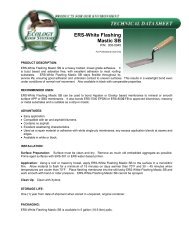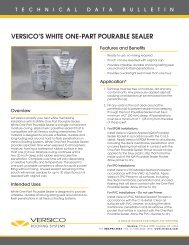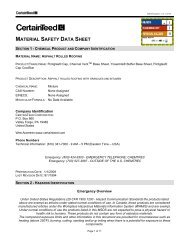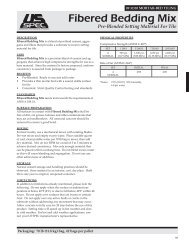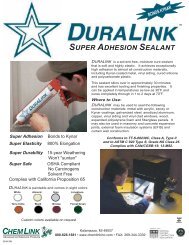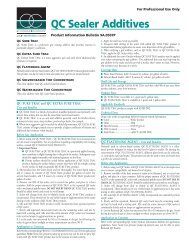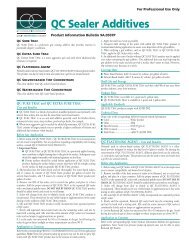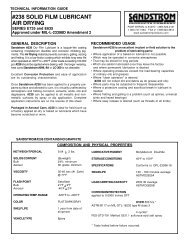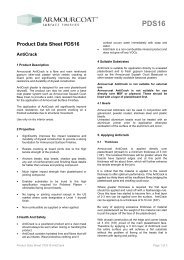Simpson Anchors - Anchoring and Fastening Systems - BuildSite.com
Simpson Anchors - Anchoring and Fastening Systems - BuildSite.com
Simpson Anchors - Anchoring and Fastening Systems - BuildSite.com
You also want an ePaper? Increase the reach of your titles
YUMPU automatically turns print PDFs into web optimized ePapers that Google loves.
22<br />
EXAMPLE CALCULATION Adhesive <strong>Anchors</strong> (Traditional ASD)<br />
Example calculation for a grouping of adhesive anchors<br />
using ASD:<br />
Design a connection <strong>com</strong>prised of four ³⁄₄" diameter all-thread rods<br />
installed in f' c = 2,000 psi concrete using SET adhesive as shown.<br />
The anchor grouping is subject to an applied tension load of 3,000 lb.<br />
<strong>and</strong> an applied shear load of 1,000 lb. acting simultaneously.<br />
ADDITIONAL DATA:<br />
• All-thread rod material: ASTM A307.<br />
• All-thread rod embedment depth: 6³⁄₄"<br />
• All-thread rod spacing: S1=S3=8", S2=11.3" (use 11")<br />
(S critical = 27" > S actual , therefore reduced effi ciency.)<br />
• All-thread rod edge distance: C1=C2=3"<br />
(C critical = 10¹⁄₈" > C actual , therefore reduced effi ciency.)<br />
SOLUTION:<br />
Unadjusted allowable tension loads:<br />
Based on adhesive bond strength = T bond = 10,525 lbs.<br />
Based on steel strength = T steel = 8,460 lbs.<br />
Unadjusted allowable shear loads:<br />
Based on concrete strength = V conc = 6,310 lbs.<br />
Based on steel strength = V steel = 4,360 lbs.<br />
Calculate reduced effi ciency factors for all-thread rod installed at<br />
an edge distance of 3" using tables on pages 48–49:<br />
Tension: C1=C2=3", f c = 0.56 from f c - Tension Table<br />
Shear: C1=C2=3", f c = 0.29 from f c - Shear Table<br />
Calculate reduced effi ciency factors for all-thread rod installed at<br />
a spacing of 8" using tables on pages 50–51:<br />
Tension: S1=S3=8", f s = 0.91 from f s - Tension Table<br />
S2=11", f s = 0.925 from f s - Tension Table<br />
Shear: S1=S3=8", f s = 0.95 from f s - Shear Table<br />
S2=11", f s = 1.00 from f s - Shear Table<br />
Reduce allowable tension value based on bond strength. The reduction<br />
factors are cumulative due to the infl uence of two reduced edge distance<br />
conditions <strong>and</strong> three reduced spacing conditions:<br />
(T bond )net = (f c )(f s )(T bond )<br />
= (0.56 x 0.56)(0.91 x 0.91 x 0.925)(10,525 lbs.)<br />
= 2,528 lbs.<br />
Allowable tension value is the lesser of:<br />
Tension based on net bond strength = 2,528 lbs. (governs) or<br />
Tension based on steel strength = 8,460 lbs.<br />
For a group of 4 anchors the <strong>com</strong>bined allowable tension value is:<br />
= (4 anchors)(2,528 lbs./anchor) = 10,112 lbs. > 3,000 lbs.<br />
(design tension) O.K.<br />
(Note: If high in-service temperature is expected, the allowable based<br />
on bond/concrete should be multiplied by a strength reduction factor found<br />
in the adhesive's temperature sensitivity table.)<br />
Reduce allowable shear value based on concrete strength. The reduction<br />
factors are cumulative due to the infl uence of two reduced edge-distance<br />
conditions <strong>and</strong> three reduced spacing conditions:<br />
(V conc )net = (f c )(f s )(V conc )<br />
= (0.29 x 0.29)(.95 x .95 x 1.00)(6,310 lbs.)<br />
= 478 lbs.<br />
Allowable shear value is the lesser of:<br />
Shear based on net concrete strength = 478 lbs. (governs) or<br />
Shear based on steel strength = 4,360 lbs.<br />
For a group of 4 anchors the <strong>com</strong>bined allowable shear value is:<br />
= (4 anchors)(478 lbs./anchor) = 1,912 lbs. > 1,000 lbs.<br />
(design shear) O.K.<br />
(Note: If high in-service temperature is expected, the allowable shear<br />
based on bond/concrete should be multiplied by a strength reduction<br />
factor found in the adhesive's temperature sensitivity table.)<br />
Four Anchor Layout<br />
The allowable tension (or shear) value for a group<br />
of anchors is equal to the lowest (minimum) tension<br />
(or shear) value for a single anchor within the group<br />
multiplied by the number of anchors within the group.<br />
CHECK COMBINED TENSION AND SHEAR INTERACTION:<br />
For adhesive anchors, use the straight-line method (n=1.0, see<br />
Figure 1) when calculating the interaction of both tension <strong>and</strong> shear<br />
upon the anchor per the following equation:<br />
(Design shear/allowable shear) n + (Design tension/allowable tension) n<br />
≤ 1.0, n=1.0<br />
Design shear (V) = 1,000 lbs.<br />
Allowable shear (V all ) = 1,912 lbs.<br />
Design tension (T) = 3,000 lbs.<br />
Allowable tension (T all ) = 10,112 lbs.<br />
(1,000/1,912) 1.0 + (3,000/10,112) 1.0 = 0.82 ≤ 1.0 O.K.<br />
Figure 1<br />
Would you like help with these calculations?<br />
Visit www.simpsonanchors.<strong>com</strong> to download the<br />
<strong>Simpson</strong> Strong-Tie ® Anchor Designer software.<br />
C-SAS-2009 © 2009 SIMPSON STRONG-TIE COMPANY INC.



